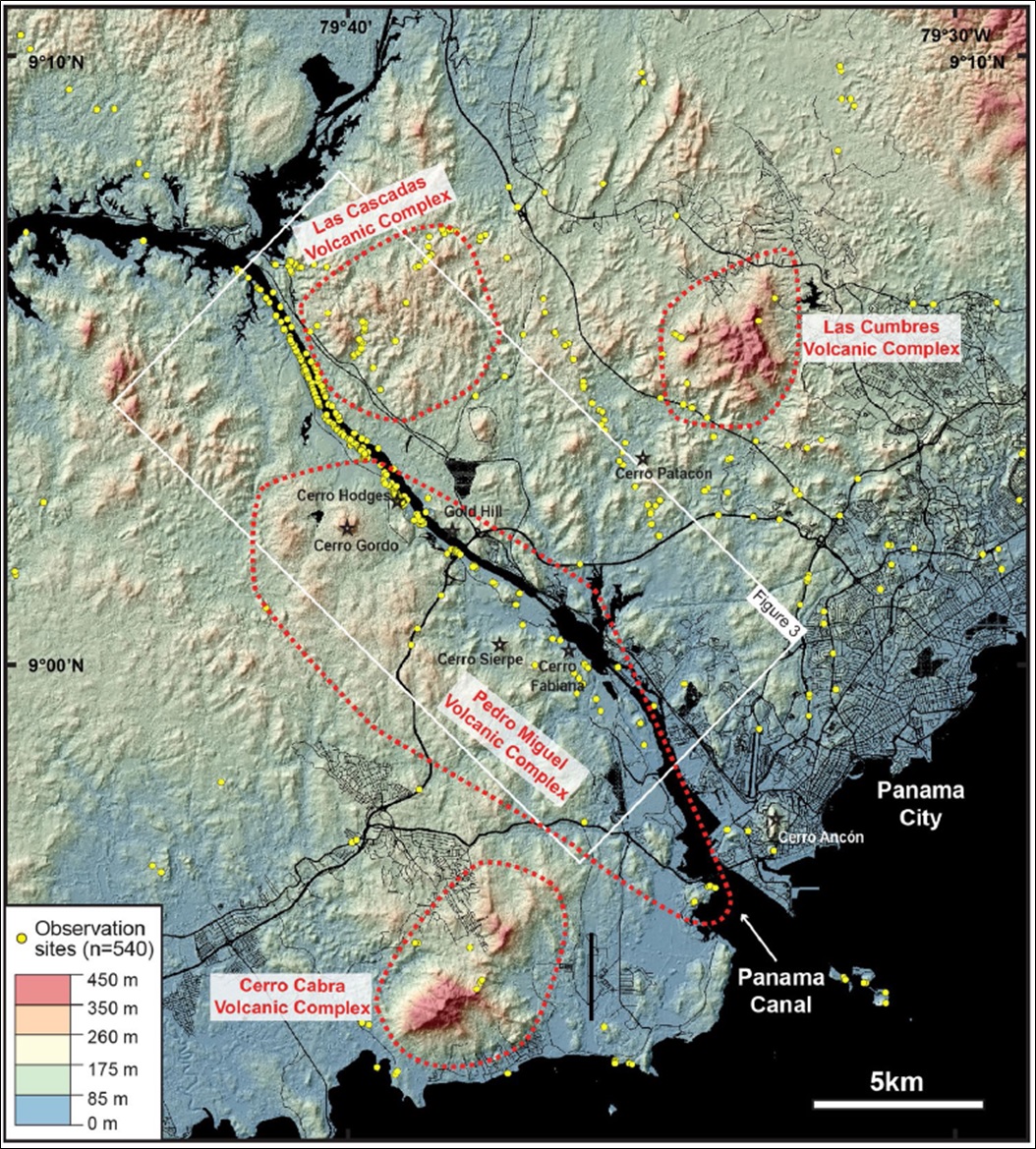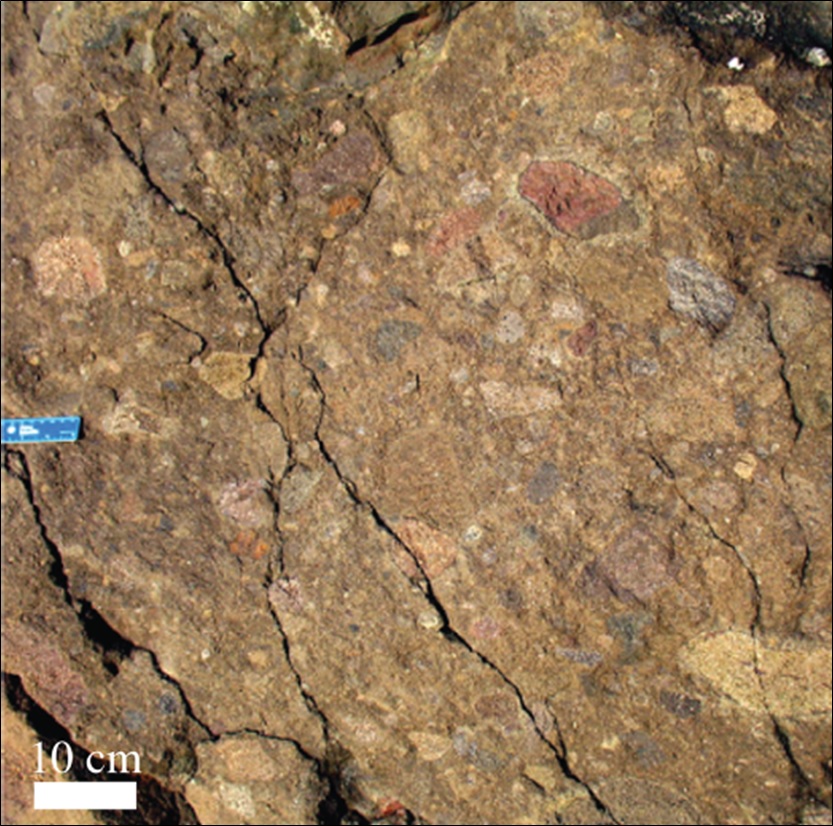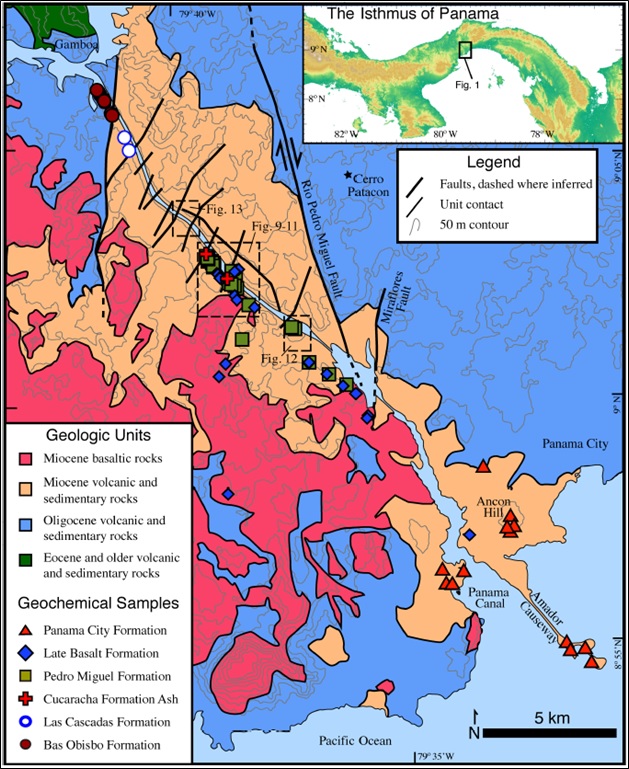Bas Obispo Fm
Type Locality and Naming
Type Locality is at Culebra Cut (Figure 1).
[Figure 1: (left) Topography of the Central Panama in the southern Panama Canal area and its main volcanic complexes (Buchs et al. (2019)). Digital topography model based on Lidar survey by the Panama Canal Authority. The geological details of the area within the white rectangle (figure 3 of Buchs et al. (2019)) can be seen in right. (right) Geology of the southern part of the Panama Canal (Culebra Cut and new Pacific locks area). (A) Revised geological map. (B) Revised chronostratigraphic chart with previous and new geochronological constraints (new data in dark circles and bold text) (Buchs et al. (2019)).]
Synonym: Obispo Fm, Obispo Breccia, Obispo Limestone Fm
Lithology and Thickness
The Bas Obispo sandstone is an immature lithic arenite with angular fragments of andesite, feldspar, clinopyroxene and opaque minerals with dark gray to black welded basaltic pyroclastic (Figure 2 (bottom right))deposits that contain abundant rounded and vesiculated lava clasts and blocks. Individual volcanic beds are not clearly defined. A general westward dip of between 14 to 50 degrees can be identified depending on outcrop. The unit is also folded (Farris et al. (2017)). The clasts in the sandy matrix are composed of porphyritic andesite with multiply zoned plagioclase and clinopyroxene. Lithification of the Bas Obsipo Fm is highly variable (hard to crumbly) due to heterogenous cementation by authigenic clay (no volcanic welding). The andesite clasts have a very consistent geochemical signature which is distinct from other units of the Culebra Cut. These observations indicate that this sedimentary unit was formed by proximal reworking from a volcanic sequence without younger equivalent along the Culebra Cut. (Buchs et al. (2019)).
Thickness: Unit thickness is estimated at between 300±1500m, with the large range being due to structural uncertainty and the difficulty in correlating individual outcrops.
[Figure 2: Field photo. Top left: welded basaltic pyroclastic rocks characteristic of the Bas Obispo Fm. Photo from Farris et al. (2017). Top right: Volcanogenic fluvial conglomerate in the Bas Obispo Fm, with clast imbrication. Buchs et al. (2019). Bottom left: Layered volcanogenic pebbly sandstone in the Bas Obispo Fm. Inset shows mud drapes. Buchs et al. (2019). Bottom right: Pyroclastic breccia outcropping at the level of the Panama Canal. Barat (2013).]
Relationships and Distribution
Lower contact
Upper contact
Regional extent
GeoJSON
Age
Depositional setting
Additional Information
References:
- MacDonald (1913a, 1913b), Wilmarth (1938).
- Jones (1950). Thickness of formation is 2,500 feet in Gatún Lake area where it underlies Las Cascadas Fm and base is not exposed. Underlain by Gatuncillo Fm west of Madden Basin only.
- Woodring (1957). Volcanic rocks now included in Bas Obispo Fm and Las Cascadas agglomerate were named Obispo Fm or breccia by Howe (1907c). Emendation to Bas Obispo Fm and splitting off of younger part as Las Cascadas agglomerate were proposed by MacDonald (1913a, 1913b). These volcanic rocks are interpreted to represent pyroclastic rocks that accumulated at periphery of a volcanic pile. Bas Obispo is thought to grade into Bohío Fm. Thickness unknown. Volcanic rocks now included in Bas Obispo Fm and Las Cascadas agglomerate were named Obispo Fm or Obispo breccia by Howe (1907c). Emendation to Bas Obispo Fm and splitting off of younger part as Las Cascadas agglomerate were proposed by MacDonald (1913a, 1913b). Doubtfully referred to Oligocene because of inferred relations to Bohío Fm
- Woodring (1960). The name was changed to Bas Obispo, the name of the locality for which the formation was named, and the formation was restricted so as to be made up mostly of agglomerate having a matrix of hard tuff. Northern Gaillard Cut is the type region. The Bas Obispo Fm is recognized along and near the Canal. Toward the SW it is not differentiated in a volcanic complex. Toward the NW it grades into the Bohío Fm.
- Keroher et al. (1966), Stewart and Stewart (1980); Montes et al. (2010); Rooney et al. (2011); Farris et al. (2017); Buchs et al. (2019).


